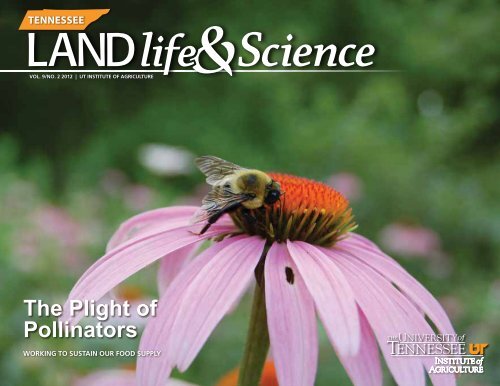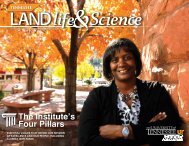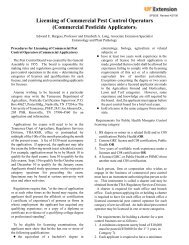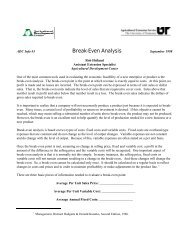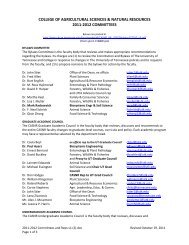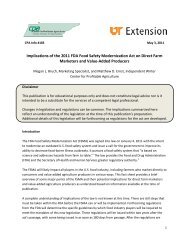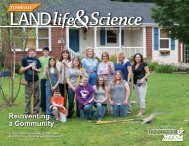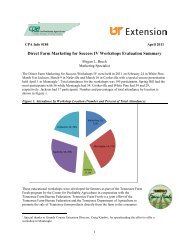The Plight of Pollinators - The University of Tennessee Institute of ...
The Plight of Pollinators - The University of Tennessee Institute of ...
The Plight of Pollinators - The University of Tennessee Institute of ...
Create successful ePaper yourself
Turn your PDF publications into a flip-book with our unique Google optimized e-Paper software.
Newsaround theinstituteOrganic land-grant assessmentgives institute top score<strong>The</strong> Organic Farming Research Foundation hasranked the institute’s organic and sustainable cropproduction program as one <strong>of</strong> the top six organicprograms in the country.Different universities were scored in the 2012 OrganicLand Grant Assessment with six receiving thefull eight points possible. UT is the newest additionto this assessment, yet still received top honors.“We are very proud that the program has been recognizedas one <strong>of</strong> the best in the nation,” says JoeGaines, assistant commissioner for market developmentat the <strong>Tennessee</strong> Department <strong>of</strong> Agriculture.“<strong>Tennessee</strong> agriculture is very diverse, and we areglad that <strong>Tennessee</strong> organic farmers will benefitfrom the work being conducted by the university.”Each university was scored based on organic research,extension and education. <strong>The</strong> assessmentcan be downloaded as a PDF from the OFRF websiteat http://tiny.utk.edu/organicsranking.– Stephanie GraysonRich Maxey4Ginger RowseyAgriculture ProudAnimal science master’s student Ryan Goodmanis Agriculture Proud. That’s the name <strong>of</strong>his Facebook community page. Goodman tellsagriculture’s story, particularly to people unfamiliarwith real agriculture and food production.Consider sharing this link with folks whoneed a basic and interesting easy read about ag,and ranching in particular. He also blogged,and past entries can be found atwww.agricultureproud.com.
Newsaround theinstituteMabel's Journey<strong>The</strong> doctors and technicians <strong>of</strong> the UT VeterinaryMedical Center continue to change Mabel’s life.Last spring, we introduced you to the beagle mix,who arrived at an animal shelter last Decemberweighing 67 pounds, more than three times herideal weight. Since that time, Mabel has been workingthat weight <strong>of</strong>f through the medical center’snutrition and rehabilitative services. In November,Mabel weighed 29.3 pounds and was closing in onher target <strong>of</strong> 23 pounds. Just like humans, it’s regularexercise and healthy nutrition that are leadingto the positive change.Pictured clockwise from top, a lively and trim Mabel inSeptember; Mabel when adopted in December 2011; startingon an underwater treadmill in January; and Mabel withSara <strong>of</strong> the Today show when the program broadcast fromKnoxville's campus in September. (Credits: the College <strong>of</strong>Veterinary Medicine)8
In pr<strong>of</strong>ile:Dr. Paris LambdinNot everyone has a symposium in hisor her honor, but that’s exactly what happenedwhen the Entomological Society <strong>of</strong> Americamet in Knoxville in November.What’s it like having asymposium in your honor?To me, it’s an opportunity to see some<strong>of</strong> my former students and colleagues.To see them and personally congratulatethem for the excellent peoplethey’ve become is exciting.What are the proudestmoments <strong>of</strong> your career?I am proud <strong>of</strong> the students I’ve beenable to assist along the way, and I ampleased for the opportunity to helpthem when they needed it most. Iam fortunate to be able to work in anarea that I thoroughly enjoy, such asbiocontrol <strong>of</strong> exotic species and systematics.That’s been a great pleasurefor me.You’ve named 36 insect speciesand some new genera. Howdoes one do that?Naming a new species is rather easy;it’s finding and describing a newspecies that’s difficult. Discovery <strong>of</strong>new species may be fortuitous whileinvestigating a specific insect group.Once you determine a species maybe new, you study its morphology,behavior and ecology to establish if itis indeed a new species or a deviant <strong>of</strong>a known species.In the past 100 years, whichdevelopments have hadthe greatest impact onentomology?<strong>The</strong>re have been numerous discoveries.For example, the revolution in theadvancement <strong>of</strong> chemicals to protectcrops and forests from insect pestsand diseases almost instantaneouslycontributed to a higher standard <strong>of</strong>living for everyone by providing accessto higher quantities and quality<strong>of</strong> food. Also, the development <strong>of</strong> variouscontrol tactics for pests responsiblefor insect-borne diseases has ledto healthier populations throughoutthe world. Advances in the realm <strong>of</strong>genetics have provided us a differentway to view insects that we did nothave earlier. Such breakthroughsgreatly contribute to the importanceand impact <strong>of</strong> entomology on society.Why are people afraid<strong>of</strong> insects?I <strong>of</strong>ten have students fearful <strong>of</strong> insectsin class, so I try to impress on themthat, like many things in life, thereare species that are beneficial, suchas honeybees that pollinate crops thatprovide us with food to eat, and thenthere are those species that causeharm or disease to us or our crops.<strong>The</strong> fortunate thing is that <strong>of</strong> the millionor so known species in the world,only a relatively small number areconsidered major pests and, to somedegree, we can manage the populationsize for many <strong>of</strong> these species.As a mentor to students and foe <strong>of</strong> exoticpests and weeds, Lambdin, pr<strong>of</strong>essor <strong>of</strong>entomology and plant pathology, hasserved the institute and his pr<strong>of</strong>ession.9
10BEESERIOUS,REALLYCarol Reese<strong>The</strong> <strong>Plight</strong> <strong>of</strong> <strong>Pollinators</strong>John Skinner and his colleague MichaelWilson have always been serious aboutbees, but they and other bee scientists throughoutNorth America really have their work cut outfor them. In 2006, the mysterious colony collapsedisorder (CCD) caused extensive bee colony lossesmeasuring regionally between 30 and 90 percent.<strong>The</strong> bee colonies died for no apparent reason.CCD creates alarming headlines and blog posts theworld over because bees are responsible for aboutone mouthful <strong>of</strong> food out <strong>of</strong> every three we eat.Bees pollinate many <strong>of</strong> the crops that provide ourfood, and as Skinner is fond <strong>of</strong> saying, “If you liketo eat, you need bees.”<strong>The</strong> phenomenon <strong>of</strong> CCD coincided with therelease <strong>of</strong> the National Research Council report Status<strong>of</strong> <strong>Pollinators</strong> in North America, which outlineddeclines <strong>of</strong> all pollinators — not just honeybees, butalso bumblebees and more than 4,000 native beespecies that pollinate most <strong>of</strong> our plants and trees.This dire situation became the focus <strong>of</strong> a multiinstitutionproject supported by U.S. Department<strong>of</strong> Agriculture’s National <strong>Institute</strong> <strong>of</strong> Food andAgriculture (NIFA). In this coordinated agriculturalproject (CAP), Skinner, a UTIA pr<strong>of</strong>essor <strong>of</strong>entomology, and Wilson, a UT Extension specialist,are members <strong>of</strong> a team <strong>of</strong> research and Extensionexperts studying CCD. Skinner and Wilson’s contributionis to develop and maintain the Bee HealthCommunity <strong>of</strong> Practice for the national Extensionwebsite, eXtension (http://www.extension.org/bee_health). <strong>The</strong> two are providing CAP membersand eXtension users research-based informationabout bees and beekeeping as well as news and currentresearch in apiculture.Scientists now understand that CCD is part <strong>of</strong> amuch bigger concern called bee decline. Skinnersays the current theory is that bee decline resultsfrom a combination <strong>of</strong> stressors on bee health,including exotic mites, new viruses and diseases,poor nutrition, pesticides, and stress caused bymoving bee colonies for the purpose <strong>of</strong> pollinatinglarge crops. “All beekeeping is local,” says Skinner.“So in regions where not enough pollinators areavailable to service a large crop, producers importbees. For example, more than 1.25 million coloniesare annually imported to California to pollinate themassive almond crop each spring. Many crops likecereals and grains are wind pollinated, but othervaluable species, especially vegetables, requireinsect pollination.”<strong>The</strong> successes <strong>of</strong> the first CAP grant lead to USDAapproval for additional and promising studies. Skinnerand Wilson are involved in the Bee InformedPartnership (BIP), through which scientists aresurveying beekeepers throughout the U.S. to determinewhat tactics are aiding colony survival.Skinner is co-chairing a symposium, “Perspective <strong>of</strong>Bee Decline: Situation, Strategies and Successes,” atthe annual meeting <strong>of</strong> the Entomological Society <strong>of</strong>America in Knoxville in November. This symposiumwill bring new information and address global issues.What about the native pollinator species? <strong>The</strong>se tooare in decline, but their exact populations remainuncounted because they are not commerciallymanaged. Skinner and Wilson are also involved ina project that will study native bees such as bumblebees,squash bees, leaf cutter bees and diggerbees, and Skinner credits the attention focused on
Jean TsaoAbove: Dr. Graham Hickling inspects a corduroy “drag cloth” usedto survey the abundance <strong>of</strong> questing ticks in understory vegetationin Illinois. Left: A nymphal blacklegged tick waits in the leaf littermidsummer for a passing host. Below: UT wildlife health studentsuse a lint roller to collect larval lone star ticks, known as seed ticks,from a drag cloth during early fall in East <strong>Tennessee</strong>.12Graham HicklingGraham Hickling
Precautions for tick-bornedisease should extendbeyond LymeGraham Hickling<strong>Institute</strong> research highlights disease risks <strong>of</strong> spreading ticksA vial <strong>of</strong> adult blacklegged ticks collected during winter near Tallahassee, Fla.When a tick bite results ininfection, most people thinkfirst <strong>of</strong> Lyme disease. But dependingon where you live, the disease may besomething else entirely. While Lymedisease, which is transmitted by blackleggedticks, is common in the Northeastand Upper Midwest, ticks in theeastern U.S. collectively carry morethan a dozen agents that can causehuman disease, says biologist GrahamHickling, director <strong>of</strong> the institute’sCenter for Wildlife Health.Sometimes the differences in diseasesymptoms are subtle. <strong>The</strong> bite <strong>of</strong>the lone star tick can also create abull’s-eye rash that appears like that<strong>of</strong> Lyme disease, but the rash isn'tcaused by the Lyme bacteria. Scientistssay that this almost certainly leadsto misdiagnosis <strong>of</strong> some patients.A National Science Foundation-fundedstudy under way at the institute isdocumenting the geographic variation<strong>of</strong> tick-borne diseases in theeastern United States. <strong>The</strong> project ispart <strong>of</strong> a four-year research initiativeinvolving investigators at five universities.<strong>The</strong>ir research is yielding the firstsystematic, regionwide look at tickdistributions and tick-borne diseases.Field studies led by Hickling havefound no occurrence <strong>of</strong> Lyme diseasein more than a thousand blackleggedticks sampled in <strong>Tennessee</strong>. Instead,lone star ticks, which are prevalent inthe state, have been found carryingthe bacteria that cause erlichiosis andrickettsiosis, which includes RockyMountain spotted fever. Last spring,the <strong>Tennessee</strong> Department <strong>of</strong> Healthreported a 500 percent increase intick-borne rickettsiosis.Ehrlichiosis and Rocky Mountainspotted fever were once uncommonin <strong>Tennessee</strong>, but lone star ticks havebeen moving north in recent decades,just as Lyme disease is spreading out<strong>of</strong> the Northeast and Upper Midwest.Lyme-infected blacklegged ticks presentlyare spreading south through Virginia,and increases have been seenthis past year in Ohio and Kentucky.<strong>The</strong> scientists believe changing environmentalconditions are behindthe shifts, as well as regional variationin the wildlife hosts used by ticks. Aswildlife populations, forest habitatsand weather patterns change acrossthe continent, so does the geographicdistribution <strong>of</strong> ticks and the diseaseorganisms they carry.“Identifying health risks in the face<strong>of</strong> changing climates will be criticalin coming years,” says Sam Scheiner,National Science Foundation programdirector for the joint NSF-National <strong>Institute</strong>s <strong>of</strong> Health Ecologyand Evolution <strong>of</strong> Infectious Diseasesprogram, which is funding the tickresearch.“This study will inform public health<strong>of</strong>ficials about what diseases are foundin which areas,” says Scheiner, “so theycan minimize human health problems.”<strong>The</strong> biologists say they are happy thatrecent treatment recommendationshave begun to emphasize the importance<strong>of</strong> considering the tick speciesand its infection status as part <strong>of</strong> thediagnostic process.<strong>The</strong>ir advice: Stay open-minded aboutwhich tick-borne diseases are mostcommon in your area — and save thetick that bites you. – NSF news report13
Giving voiceto wildlife“I know that Ican do anything.Anyone can. Youjust have to learnyour life’s purposeand dedicateyourself to it.”©Steve Winter/National GeographicBorn into Brooklyn, Rabinowitz has reached the world’s wildestplaces to create preserves and political will to conserve wildlife.14©Steve Winter/Panthera©Steve Winter/National Geographic
For Alan Rabinowitz, a career thatbegan as a student conductingfieldwork through the Department<strong>of</strong> Forestry, Wildlife and Fisheries hasgrown into a magnitude <strong>of</strong> achievementsin global wildlife conservation.Working to preserve the world’s lastwild places, Rabinowitz (M.S. ’78,Ph.D. ’81, ecology) has negotiatedwith the leaders <strong>of</strong> nations to createpreserves and political will to conservewildlife. Through saving territoryfor big cats, the apex predators,he has led to the establishment <strong>of</strong>areas that protect entire ecosystems <strong>of</strong>living things.Rabinowitz convinced the dictators <strong>of</strong>Myanmar to create the world’s largesttiger preserve. In Belize, his workresulted in the world’s first jaguarsanctuary. In Taiwan, he negotiatedthe establishment <strong>of</strong> that country’slargest protected area and last piece<strong>of</strong> intact lowland forest. And in SouthAmerica, he and his organization Pantherahave pieced together biologicaland genetic corridors designed to allowjaguars to move across their entirerange from Mexico to Argentina.As Rabinowitz tells it, it all began withstuttering. As a child, his stutter wasso severe that he could not speak tohumans. But he discovered he couldtalk to animals. With them he did notstutter. Drawn to wildlife at the zoo,he made a promise that if he everlearned to overcome his stutter, hewould give voice to animals to protecttheir future. He did, and he has. Hesays the focus <strong>of</strong> mind that led him t<strong>of</strong>ind his voice taught him how to worktoward incredible goals, to persevereagainst all odds.“I was told the Jaguar Corridor wastoo ambitious. It’s now being implementedby many <strong>of</strong> the jaguar countriesthroughout Latin America. I wastold that I’d never get to the dictators<strong>of</strong> Myanmar. It took five years, but Inot only reached them, I had themsign <strong>of</strong>f on the world’s largest tigerreserve in one <strong>of</strong> the world’s most oppressivegovernments.“I know that I can do anything. Anyonecan. You just haveto learn your life’spurpose and dedicateyourself to it.”For big cats and otherwildlife to survive,he says people needto learn to live withthem, to not see themas adversaries.“We see a big cat inthe zoo or go to apark, but they’ve gotto be safely distant.People need to realizethere can very well bea world where we liveamong the big predators.It sounds almostclichéd, but people trulyhave to figure out thathuman beings are a part<strong>of</strong> nature and not apartfrom it. <strong>The</strong> more weplace ourselves apartfrom nature and think wecan control it, especiallythrough technology, themore we speed up ourdemise and that <strong>of</strong> thenatural world.”Through that vision and the achievementsthat back it, Rabinowitz continuesto give voice to the animals. Hesees it as vital, for their sake and forhumankind. – Margot EmeryUT alum Alan Rabinowitz discovered theworld’s most primitive deer, the leaf deer.Alan Rabinowitz is not the only personaffiliated with UTIA fighting to protectbig cats. See page 26 to learn about theUT Veterinary Medical Center’s work tosave an African lion.©Alan Rabinowitz ©Steve Winter/National GeographicWatch a video about Alan Rabinowitz’s life at his organization,Panthera, www.panthera.org/video/man-and-beast.15
Country hamsas teachable momentsCountry hams are a tradition in theSoutheast, cherished for the way theysummon memories <strong>of</strong> old-time ways <strong>of</strong> doingthings, such as how parents and grandparentspreserved meat and served it on the farm.In three <strong>Tennessee</strong> counties, 4-H youth arelearning to cure country hams. Through the4-H Country Ham Project, the 4-H’ers gaininsight not only into their agricultural heritage,but also in important life skills such asrecord keeping and public speaking, personalresponsibility and self-esteem.“So many <strong>of</strong> our young people think foodcomes from Walmart or the drive-through,”says Michael Murphey <strong>of</strong> family business CliftyFarm in Paris, Tenn.Elizabeth Cook“As the 4-H’ers prepare their hams, you canalmost see the light bulb come on as they realizehow food is produced.”16Elizabeth Cook
“So many <strong>of</strong> our youngpeople think food comes fromWalmart or the drive-through.”Elizabeth CookYouth in grades four through 12 inWest <strong>Tennessee</strong>’s Henry and Bentoncounties have the opportunity toparticipate in the ham project withClifty Farm, a major supplier <strong>of</strong>country hams and meats throughoutthe Southeast. In Middle <strong>Tennessee</strong>’sRutherford County, 4-H’ers join withMurfreesboro-based business <strong>The</strong>Hamery.At Clifty Farm, preparing a ham typicallytakes 100 days. <strong>The</strong> process startswith cleaning freshly processed hamsthen curing them with salt, washing,bagging and aging them and thengiving the hams a flavorful hickorysmoke at the end. “We have a particularway <strong>of</strong> doing things,” Murpheysays. “We’re proud <strong>of</strong> how we take ourtime with the product, particularly inan era <strong>of</strong> everything being so fast.”Youth cure two hams, selecting thebest for the county fair and taking theother one home to enjoy with family.During the project, they track eachstage <strong>of</strong> the curingprocess, documentinghow their hamsmature and recordingtheir weight asthey dry. Summingup the experience,they give a speechto families andfriends on what ittakes to preparea ham or theirexperiences through the process.“It’s not uncommon to see an audience<strong>of</strong> 50-plus people following theirevery word,” says UT 4-H Extensionagent Staci Foy, who coordinates theham project with Clifty Farm.“This project is a way for youth inrural cities, as well as in agriculturalareas, to participate in a 4-H projectand the fair,” Foy says.“Not everyone has the ability to raisea lamb or steer or hog or take part ina chick chain. Through preparing acountry ham, they get to experiencea hands-on 4-H project. I think that’swhy we have such high participation.”Some 300 youth have cured hamsthrough the project. In Murfreesboro,<strong>The</strong> Hamery owner Bob Wood believesin passing along his knowledge<strong>of</strong> country hams to others.“One generation really owes a responsibilityto the next to pass on what weknow,” he says.For 4-H’er Savannah Sandlin, it wasan irresistible opportunity.“I was like, ‘Well, it looks fun and youget to eat it, so let’s just jump in.’”<strong>The</strong> lessons the projectteaches matter.“What 4-H is trying to teach is nothow to cure a ham,” says BarbaraDavenport, 4-H agent in RutherfordCounty with UT Extension. “We’reteaching the young people life skillslike responsibility, achieving goals andself-esteem.”All through a special, much-lovedcountry food. – Margot Emery andChuck Denney17
Celebrating our land-grant heritageMorrill Act marks 150 years18Left: In the midst <strong>of</strong> the Civil War, President AbrahamLincoln signed the Morrill Act into law. Right: Justin S.Morrill transformed UT and other land-grant universities.(Credits: Library <strong>of</strong> Congress)
UT President Charles Dabney tries out anew plow at the College Farm around 1904.Dabney reorganized the university to focusmore on scientific and agricultural subjects.A lthough you may not have realized it, 2012marks an extraordinary year for our alumni andthe thousands <strong>of</strong> citizens the institute serves in itseducational, research and Extension programs.This year, the institute and UT, along with otherland-grant universities throughout the nation, arecelebrating the 150th anniversary <strong>of</strong> the MorrillAct. This act has directly affected the education thateach <strong>of</strong> our students has received, from the presentback to the years following 1862, when PresidentAbraham Lincoln signed the legislation into law.<strong>The</strong> Morrill Act established land grants for eachstate, allowing states to receive payment from sales<strong>of</strong> public lands. <strong>The</strong> states were charged to usethese funds to create “such branches <strong>of</strong> learning asare related to agriculture and the mechanic arts …in order to promote the liberal and practical education<strong>of</strong> the industrial classes in the several pursuitsand pr<strong>of</strong>essions <strong>of</strong> life.”It was the Morrill Act that opened schools <strong>of</strong> highereducation to citizens from all walks <strong>of</strong> life, not justthe privileged few. <strong>The</strong> legislation also laid thegroundwork for the establishment <strong>of</strong> agriculturalresearch programs and outreach by Extensionagents, created through the subsequent Hatch andSmith-Lever acts <strong>of</strong> 1887 and 1914. <strong>The</strong> secondMorrill Act <strong>of</strong> 1890 established historically blackcolleges and universities as land-grant institutions,and <strong>Tennessee</strong> State <strong>University</strong> <strong>of</strong>ficially became<strong>Tennessee</strong>’s second land-grant university in 1958.“This is an exciting time to be celebrating the 150thanniversary <strong>of</strong> the land-grant universities and whatJustin Morrill did to create them,” says instituteChancellor Larry Arrington. “To think about theimpact that this one law had — that’s a revolutionarypiece <strong>of</strong> educational legislation in this country,and it’s the reason today that one farmer can feedso many people.“Our farmers are able to do that because <strong>of</strong> all thetechnology and change that have occurred as aresult <strong>of</strong> having a land-grant university system inthe country, where new technology is developedand makes its way into the classroom to train futurepr<strong>of</strong>essionals, and also makes it out into the communitiesand onto the farms.”It’s tempting to speculate that Vermont native JustinMorrill foresaw such far-reaching impacts <strong>of</strong> thelegislation he drafted. Although his formal educationended when he went to work as a store clerk atage 14, he went on to a successful career in businessand farming. In 1854, he was elected to Congress,serving first in the House <strong>of</strong> Representatives, thenin the Senate. In 1858, he introduced the legislationto create public schools <strong>of</strong> higher education toprovide training in the applied fields, as well as intraditional liberal arts.Winning passage wasn’t easy. Morrill’s first billnarrowly passed in Congress, only to be vetoed byPresident James Buchanan, on the grounds that,historically, educational matters had been left tothe states.But Morrill, who sought to open universities to whathe called “regular people,” ultimately prevailed and,despite the turmoil <strong>of</strong> the Civil War years, the billwon passage, with Lincoln signing it into law in 1862.In this anniversary year, the institute, its academicdepartments and units have reflected on theirland-grant heritage and explored how it informstheir mission and focus. In early November at AgDay, the institute’s annual street fair for alumni andfriends, Chancellor Arrington, university PresidentJoe DiPietro and UT Knoxville Chancellor JimmyCheek dedicated historical markers to be placedat the institute and on the Knoxville campus, tocommemorate the land grant act that continues toshape our mission and the education our studentsreceive. – Margot Emery19
<strong>Institute</strong>’s first Farm Credit Scholarsstart their studiesPeyton GrahamThis autumn, the institute’s inaugural class <strong>of</strong> FarmCredit Scholars began their studies in the College<strong>of</strong> Agricultural Sciences and Natural Resources. Earlierthis year, the institute and Farm Credit Services <strong>of</strong> Mid-America announced the scholarship program that bringsthem to campus.<strong>The</strong> program selects outstanding students for specializedstudies in CASNR. <strong>The</strong> Farm Credit Scholars will engagein customized coursework, as well as an internationalexperience, mentoring opportunities and a Farm Creditinternship. Students may enter the program in theirfreshman year and renew the scholarship for a total <strong>of</strong>four years <strong>of</strong> study, provided they meet the requirementsfrom the previous year.“Farm Credit saw the need to attract a high caliber <strong>of</strong> student,and with this initial group <strong>of</strong> Farm Credit Scholars,the program is <strong>of</strong>f to a very successful start,” says Dr. LarryArrington, chancellor <strong>of</strong> the institute.As Farm Credit Scholars, the students take courses inagricultural law, finance, policy and sales, rural development,leadership, and production agriculture.In addition, students are required to completea research project with written and oralreports to Farm Credit leadership, studentsand faculty.According to program coordinator John Riley,the initial group <strong>of</strong> scholars is up to the challenge.“We had excellent applications this year,and we expect that will hold true for the future, as this isa very competitive scholarship opportunity.”CASNR Dean Caula Beyl says the world faces a criticalneed for agriculture majors and the future job market istremendously strong. “<strong>The</strong>re are exciting careers becauseyou know that you’re fulfilling something that is veryimportant. By 2050, the world’s population is estimated tobe 9 billion people, if not more. As long as people needfood, fiber and fuel, agricultural careers are going to bein the forefront.”“We’re looking for the brightest and most exceptionalstudents across all segments <strong>of</strong> agriculture,” explainsDavid Lynn, Farm Credit senior vice president <strong>of</strong> financialservices. “We are structuring this program to bevery open. <strong>The</strong> majority <strong>of</strong> scholars may come from theagricultural economics and agricultural business curricula,but we want the program to be available to otherexceptional students in CASNR. We want these studentsto become valuable contributors to their communitiesand to agriculture.” – Doug EdlundGraham is from Munford, Tenn.,and is pursuing a degree in agriculturalbusiness. She developeda passion for agricultural financein college and during an internshipwith Farm Credit during lastsummer. “I know I want to returnto my family farm, while still beingable to have a stable career in theagricultural industry. <strong>The</strong> realityis that there are not many opportunitiesto do what I love and stillbe close to home, which is why acareer with Farm Credit is so appealingto me.”20<strong>The</strong> 2012 Farm Credit Scholars pictured fromleft to right are Forrest Duncan, Ashlee Ailshie,Peyton Graham, Erin Brinkley and BillyRochelle. Dr. John Riley, UTIA Farm CreditScholar program administrator, is also pictured.
Billy RochelleErin BrinkleyForrest DuncanAshlee AilshieAilshie, who is from Columbia,Tenn., credits her upbringing asthe foundation <strong>of</strong> her decision topursue an agriculture-related degreeand career. “My degree is agbusiness, and that will require meto take a broad range <strong>of</strong> classesthat expose me to various areas <strong>of</strong>business. I found my strength inaccounting, and I realize that accounting,financial planning, andrecord keeping are essential partsto the success <strong>of</strong> today’s farms.”A native <strong>of</strong> Nunnelly, Tenn.,Rochelle is pursuing a degree infood and agricultural business.He’s interested in a career thatwill allow him to actively representthe agricultural industry andportray agriculture as a positiveand essential industry for a growingpopulation. “From an earlyage, I knew that I wanted to spendmy life working in the agriculturalfield. I like people, the philosophy<strong>of</strong> rural life and helping peoplerealize their dreams.”Brinkley is from Jonesborough,Tenn., and is pursuing a degree inagricultural education. She’s interestedin a career in agriculturewith a focus on education, financeor policy. “As fewer people growup on farms and have less exposureto agriculture, it is importantthat we continue to influencepolicymakers and opinion leadersin support <strong>of</strong> agriculture.”Duncan comes to UT fromDecherd, Tenn., and is workingtoward a degree in agriculturalbusiness. He is a fourth generationfarmer who plans to use hisagricultural education to expandand diversify his family farm. “Iam an avid reader, and I enjoyagricultural publications. I enjoycomparing and contrasting farmingmethods in publications andthe ones I use on my family farm.”21
UT RESEARCHERSdevise new precision ag technology for row-crop producers22
Research associates Henry Moody, left, and JohnHancock measure the pulsed spray target accuracyfor each seed metered by a row-planter.<strong>The</strong> idea began with a question putto <strong>Tennessee</strong> cotton producers:What if they had a technology thatprecisely sprayed fungicide to seeds asthey were being planted?Ten producers, gathered in a conversationwith a UT biosystems engineer,said that was a technology they coulduse. Dr. John Wilkerson, an expert insensors and controls, ran with the idea.Now he and a small team <strong>of</strong> instituteresearchers have developed a new precisionagriculture technology that is beingdelivered to the marketplace, one thatwill improve the bottom line <strong>of</strong> cropproducers, both large and small.In fact, the new system, which is a specialized seedfurrow detector, is expected to cut their amount<strong>of</strong> fungicide used by 50 percent or more, dependingon seed spacing. That’s a lot <strong>of</strong> savings, andit’s good for the environment, too — a winningsolution for everyone. It’s also merited two patentsissued to Wilkerson and team members Dr. MelvinNewman and graduate students John Hancock andHenry Moody. But the real winners here are cropproducers.Using the detector, farmers will be able to ensurethat each seed going into their field is fully coatedwith fungicide without a drop being wasted. Even iftheir planter misses a seed or drops two at once, thelaser-driven applicator does not miss a beat.“We wanted a valve that would turn on and <strong>of</strong>f fastenough to spray seeds falling at a 30th to 40th <strong>of</strong>a second,” Wilkerson says. “We started thinking <strong>of</strong>fuel injectors in a car going 60 miles an hour. That’sJohn Wilkersonabout the same rate producers are plantingseeds, at 6 to 7 miles per hour.”<strong>The</strong> technology, which is licensed throughthe UT Research Foundation, is essentiallyan algorithm that detects events anddetermines when the crop protectantapplication should be made. “<strong>The</strong> typicalapplication is where we detect seedsfalling from a seed metering unit, andwe apply a chemical band on the seedbefore it hits the ground, which is a 10th<strong>of</strong> a second,” Wilkerson says.<strong>The</strong> technology was developed on researchplots at the UT AgResearch andEducation Centers in Milan and Jackson,underscoring their importance to innovation in theinstitute’s land-grant research.“To me, it’s a big deal when you take a concept andit turns into intellectual property that someone iswilling to invest in for commercial purposes thatsolve problems for producers,” Wilkerson says.“This also shows the significance <strong>of</strong> the people weserve investing in the university. This project involveda fairly small amount <strong>of</strong> investment in a grantby producers to AgResearch, which we were able toleverage into a new precision ag technology.”<strong>The</strong> planter technology is expected to becomecommercially available in the near future. For moreinformation, contact John Wilkerson at 865-974-7266 or wilkerj@tennessee.edu. – Margot EmeryThis diagram shows how the new precision agtechnology applies in-furrow crop protectants asseeds fall from the planter into the furrow.23
Who we are. What we do.1With a goal <strong>of</strong> showing who the<strong>Institute</strong> <strong>of</strong> Agriculture is and what wedo, the <strong>Tennessee</strong> Chapter <strong>of</strong> GammaSigma Delta launched an annualphoto competition this spring. <strong>The</strong> agriculturalhonor society’s contest drew77 entries by students, faculty andstaff, with images representing ourimpacts across the state. We’d like toshare a few with you.Photo Credits: 1. John Cummins 2. Carrera Romanini3. Craig Canaday 4. Jake Mallard 5. Graham Hickling6. Dena Wise 7. Jose Vargas 8. Dena Wise2324
7654825
Phil Snow“ We are s<strong>of</strong>ortunate to havesuch a medicalfacility here tohelp these cats.When we takein animals, wepromise to givethem the bestlife possible. <strong>The</strong>medical carethey receivefrom UT helps usaccomplish that.”—Mary Lynn HavenFightingto save a king26
Mary Lynn Haven criedthe first time she sawTsavo about 11 years ago. Less than 8months old, the lion cub was malnourished,infected with intestinalparasites and covered with mitescausing mange. As director <strong>of</strong> TigerHaven, a big cat sanctuary in RoaneCounty, Tenn., Haven has been rescuinglions, tigers and other big cats formore than 20 years. “It’s not a job,it’s a calling. <strong>The</strong>se cats have beenthrough so much,” Haven says aboutthe 288 animals at the 70-acre facility.“Tsavo was so pitiful. He’d had a hardlife his first year and has had medicalissues on and <strong>of</strong>f throughout his life.”But nothing prepared Haven for adiagnosis <strong>of</strong> cancer.Earlier this summer, a swollen lumpappeared on Tsavo’s face. At first,veterinarians thought a scratch hadabscessed. “When we immobilizedhim with anesthetic drugs to lance theabscess, it ended up being a large pigmented,highly vascular mass,” said Dr.James Steeil, a third-year resident inzoo medicine at the UT College <strong>of</strong> VeterinaryMedicine. Biopsies confirmedthe diagnosis: malignant melanoma.A CT scan, radiographs and regionallymph node size indicated the tumorhad not yet metastasized (spread).Given Tsavo’s age and location <strong>of</strong> themass, his medical team and caregiversturned to the linear acceleratorat UT Veterinary Medical Center todeliver radiation therapy to reducethe tumor’s size. If necessary, surgerywould follow. Dr. Nathan Lee, a CVMboard-certified radiation oncologist,scoured the literature and believesTsavo is the first lion treated withradiation. “It’s a very unique case.This type <strong>of</strong> melanoma is unusual indomestic cats, never mind big cats.”Lee hopes the knowledge gainedfrom Tsavo will help others. “Afterfour radiation treatments and immunotherapy,the tumor’s size decreasedby about 50 percent.” Advancedmedical techniques used in domesticanimals to treat cancer can be used inbig cats.Several weeks after Tsavo’s last radiationtreatment, UT veterinary surgeonswere able to remove the tumoras well as the mandibular lymph node(near the tumor site), which wasenlarged and appeared metastatic.Histopathology confirmed that indeedthe melanoma had metastasizedto the lymph node.Haven and Tsavo’s medical team areworking together to map out the carefor this king <strong>of</strong> the jungle. Right now,he sports a healthy appetite and appearsto be free <strong>of</strong> pain. Haven saysthat is the bottom line for all the catsat Tiger Haven. “We are so fortunateto have such a medical facility hereto help these cats. When we take inanimals, we promise to give them thebest life possible. <strong>The</strong> medical carethey receive from UT helps us accomplishthat.” – Sandra HarbisonOpposite page: Dr. James Steeil checks Tsavo’s vital signs before the lion is wheeledto the linear accelerator for his radiation treatment. Above: Tsavo back home atTiger Haven after a successful surgery.Mary Lynn Haven27
Pam's Mountain BouquetHello, Pam’s Mountain Bouquet!<strong>The</strong> institute’s dogwood research team is well known for its “Appalachian” series <strong>of</strong> dogwoods, which can befound or ordered at garden centers and nurseries. Appalachian Spring is resistant to dogwood anthracnose,a deadly disease for dogwoods. Appalachian Mist, Appalachian Snow and Appalachian Blush, whichcan have a pink tinge, are white-bracted cultivars that are highly resistant to powdery mildew, anotherserious threat. Appalachian Joy is also highly resistant to powdery mildew. But it’s this cultivar’s blossomsthat catch attention, because the tree has extra bracts that make for a showy spring display.<strong>The</strong> vivid white flowers ON THISnew dogwood look like nothing more thanperfect squares <strong>of</strong> white paper. Meet Pam's MountainBouquet, the latest dogwood variety developedby the institute’s team <strong>of</strong> dogwood researchers andExtension personnel.This Cornus kousa dogwood’s eye-catching fusedbracts make for a distinctive and showy springdisplay. Pam’s Mountain Bouquet joins five othercultivars that the institute has developed andreleased. <strong>The</strong> trees provide nurseries with highdemandstock and landscapers and homeownerswith lovely, disease-resistant dogwoods that enhancetheir homes and lands.<strong>The</strong> work that resulted in the new release startedmore than two decades ago, when scientists withUT AgResearch began evaluating kousa species for28
Appalachian Snow Appalachian Mist Appalachian Blushresistance to anthracnose, a serious disease that canlead to dogwood death. <strong>The</strong> best <strong>of</strong> the trees wereplanted and preserved at the UT Forest ResourcesAgResearch and Education Center in Oak Ridge,Tenn. <strong>The</strong> dogwood team then chose Pam’s MountainBouquet as the best <strong>of</strong> the best.Kousas bloom later than flowering dogwood species,extending the season <strong>of</strong> spring blooms. When hotspring weather led flowering dogwoods to bloomearly this year, it was kousas that saved the day forKnoxville’s famed Dogwood Arts Festival, bloomingas they did during the festival’s set schedule <strong>of</strong> days.In addition to Pam’s Mountain Bouquet, the dogwoodteam is releasing two cultivars that will be soldby nurseries in Japan.“<strong>The</strong> Japanese don't have a lot <strong>of</strong> space in theirgardens, so they are fascinated with tall, narrowdogwoods, which we are releasing there,” says dogwoodteam member Mark Windham, a pr<strong>of</strong>essor <strong>of</strong>plant pathology.Extension plant pathologist Alan Windham andplant pathology pr<strong>of</strong>essor Bob Trigiano are alsomembers <strong>of</strong> the dogwood team. Trigano is chiefmanager <strong>of</strong> the team’s business, Creative AgriculturalTechnologies LLC. CAT is one <strong>of</strong> UT’slongest-running spin<strong>of</strong>f companies.“Bob and I formed the company to provideAgResearch with a mechanism to release geneticallyimproved ornamental plants,” Mark Windham says.“We give <strong>Tennessee</strong> nurseries first right <strong>of</strong> refusalon our varieties for at least two years, which givesthem a head start on the market.”Pam’s Mountain Bouquet is expected to becomeavailable to homeowners in four years, allowingnurseries time to build up their stock. <strong>The</strong> team’spreviously released varieties, in their Appalachianseries, are sold at U.S. nurseries. – Margot EmeryAppalachian JoyFor more information, contact MarkWindham, mwindham@tennessee.edu, or Trigiano, rtrigano@tennessee.edu, or call 865-386-1872.29
UT Extension’s road map for the futureby Tim Cross, dean, UT Extension<strong>The</strong> zero-energy Living Light house.As I think about strategic planning, a quoteby Benjamin Franklin always comes to mymind. Franklin said, “To fail to plan is to plan t<strong>of</strong>ail.” Strategic planning can be expensive and timeconsuming, but what about the costs for an organization<strong>of</strong> not establishing a common vision, anexplicit mission statement, and strategic directionsand goals for the future? In the absence <strong>of</strong> strategicorganizational plans, each individual is left to settheir own goals and directions, which can lead toconflict, stress and tension as individual agendasare carried out. Just as in our personal lives, organizationallong-term decision-making is very challengingwith no priorities or end points in mind.According to Yogi Berra, “If you don't know whereyou're going, you'll end up someplace else.”While it’s easy to talk about the benefits <strong>of</strong> strategicplanning, what most <strong>of</strong> us want to see is directevidence that positive impacts have occurred dueto the development <strong>of</strong> a strategic plan. Cause andeffect is <strong>of</strong>ten difficult to prove, but I’d like to illustratewhat I see as several direct benefits in UTExtension that have resulted from the development<strong>of</strong> our Advancing <strong>Tennessee</strong> strategic plan.• UT Extension partnered with the College <strong>of</strong>Architecture and Design and other collegesfrom UT Knoxville to co-host a statewide tour <strong>of</strong>the award-winning Living Light solar and greenenergy home.• A new 4-H Lodge in Greeneville, Tenn., was madepossible through a private gift to the Clyde Austin30Taking research-based information to Tennesseans.<strong>The</strong> new lodge at the 4-H center in Greeneville.
4-H Center, providing a retreat style conferencefacility that will complement our summer campingprograms.• A statewide IT coordinator position was createdfor UT Extension to help lead efforts to coordinateour use <strong>of</strong> information technology statewide.• UT Extension implemented a staffing plan to balanceneeds and funding across the state.• On Jan. 1, 2012, starting salaries for UT Extensionagents were increased to $30,000 for newhires with B.S. degrees and $34,000 for new hireswho have earned their master’s. This was the firstincrease in starting salaries since 2003.4-H’er Tori Bryant learning civic engagementfrom <strong>Tennessee</strong> Gov. Bill Haslam.Read more about how UT Extension is using its strategic planat https://utextension.tennessee.edu/strategicplan.<strong>The</strong>se are just a few examples <strong>of</strong> progress we havemade in implementing our plan, which includesgoals to expand our partnerships, deliver innovativeprograms, be an employer <strong>of</strong> choice, operateefficiently and increase our visibility. I’m confidentthat you’ll see similar progress as the UT systemand all the units <strong>of</strong> the institute carry out their strategicplans in the coming years. With our continueddedication and commitment, our future is bright,and we will be well positioned to realize the visionsthat have been created. I’d like to leave you withone final quote: “<strong>The</strong> future depends on what youdo today.” Thanks to our Extension agents and specialistsfor all that they do to serve <strong>Tennessee</strong> andthe <strong>Institute</strong> <strong>of</strong> Agriculture.For more than 100 years, UT Extensionhas helped Tennesseans solve problemsand implement changing technologies toimprove the quality <strong>of</strong> life in all 95 counties.In 2010, as Extension celebratedits centennial year and reflected on itsheritage and accomplishments, it seemedan appropriate time to take an active rolein planning its future.That year, Extension launched a strategicplanning effort to map the future for thenext decade. Extensive input from employees,stakeholders and clients shapedthe goals contained in the strategic planthat will serve as a map for the future.<strong>The</strong>y include:• Preparing for future growth.• Advancing <strong>Tennessee</strong> throughinnovative programs.Strengthening individuals, families and communities through education.• Investing in Extension’s human capital.• Maximizing organizational efficiency.• Increasing visibility <strong>of</strong> UT Extension.<strong>The</strong>se goals reflect the need for innovationand technology while maintainingExtension’s tradition <strong>of</strong> community-basededucation. <strong>The</strong> plan engages employees,partners, volunteers and thoseExtension serves to positively impact<strong>Tennessee</strong> communities. Working closelywith these groups, UT Extension willadvance <strong>Tennessee</strong>.ADVANCINGTENNESSEE31
AlumniMemoriesIn 2009, Murray Miles was presented with the GammaSigma Delta Alumni Award <strong>of</strong> Merit. <strong>The</strong> agriculturalhonor society honored Miles for a lifetime <strong>of</strong> achievements.Dr. Fred Allen, Plant Sciences, (left) made the presentation,and Dr. Michael Davidson, Food Science and Technology,made the nomination.Joe AdcockDr. Joe Adcock (CVM ’79) is the first graduate <strong>of</strong>the UT College <strong>of</strong> Veterinary Medicine. Period.He’s quick to point out he wasn’t first in his classbut graced with a last name that started with theletter A. He was the very first student to walk acrossthe stage and be declared a doctor <strong>of</strong> veterinarymedicine by the <strong>University</strong> <strong>of</strong> <strong>Tennessee</strong>.“When we first started veterinary school, the presentday building didn’t exist,” Adcock says. <strong>The</strong>students in the Class <strong>of</strong> 1979 had their classes inBrehm Hall — in one classroom. “Most people inour class sat in the same chair eight hours a dayfor two years. It was a three-year curriculum withjust one week <strong>of</strong>f between quarters. It worked outfine; we didn’t have to catch a bus and ride to otherplaces, and we could leave everything at that chair.”When asked about yesteryear, Adcock laughs andsays he hesitates to share many memories. Whilethe statute <strong>of</strong> limitations may have expired,retaliation remains a possibility. “I’m not certainI want to tell too much,” he says, adding that theentire class was kept busy. “Actually, we workeda lot. Back then, the college didn’t hire a lot <strong>of</strong>people to work in the hospital and students hadto do everything. We didn’t have a whole lot <strong>of</strong>fun.” One might almost believe Adcock. Almost.It was the very last week <strong>of</strong> class, and the studentswere in the large animal facility. A massive waterfight broke out. “It wasn’t necessarily studentsversus faculty,” Adcock recalls. “It wasmore students ambush faculty! We tookadvantage <strong>of</strong> the surprise, and they didn’thave enough time to retaliate.” Witha straight face, he says the water fight,complete with filled balloons and firehoses, wasn’t his brainchild. “No, it justsort <strong>of</strong> happened and everyone jumpedon board. <strong>The</strong>y knew what they’d put usthrough.” Adcock says all but one facultymember took it in good spirits, and thatperson’s identity is a secret he’s keepingto himself. – Sandra HarbisonVeterinary medicine graduate JoeAdcock has many happy memoriesfrom his days as a student.Trevor RuszkowskiA glimpse <strong>of</strong> the CVM water fight pitting students versus faculty.32
Murray MilesWhen Murray Miles arrived on campus in 1948,there were only two main buildings on the ag campus:Morgan Hall and Ag Engineering. But McCordwas nearing completion, and in front <strong>of</strong> MorganHall stood a barn structure known as Temple Hallalong with a small lunchroom. “Mabel Davenportwas here at that time, and that’s where she wasworking,” he says. <strong>The</strong> cafeteria, in McCord fordecades now, is named Mabel’s in her honor.Miles has memories he cherishes <strong>of</strong> his time atUT. “Foremost is the friendship <strong>of</strong> people; I metso many <strong>of</strong> them. I was active in the Young Farmersand Homemakers program and the Ag Club.<strong>The</strong> Physical Education Department asked me toteach folk dances and games that I learned as a 4-Hyouth. I also had the opportunity to be a member<strong>of</strong> the UT Chorus. I thoroughly enjoyed that.”One facet <strong>of</strong> campus life specific to his time wasHome Management Houses, where students gainedpractical experience in managing a household forone quarter. “I was dating a young lady majoring inhome ec. I’d shop with her, and when she’d cook,she’d invite me over for supper. That’s where I firsttasted broccoli. It wasn’t very common at the time.”Miles arrived on campus thinking he’d major indairy, but his father, a dairyman, persuaded himto choose something else since he already knewdairying. Miles majored in agronomy. In the end,though, he entered a very different field. “I wishI had taken more, but I only took one quarter <strong>of</strong>Just a month before entering UT in 1948, Miles was elected state 4-HCouncil president. Miles is fourth from the left on the front row.journalism, and then I ended up editing the largestcirculation newspaper in <strong>Tennessee</strong>, the Farm BureauNews. So you never know where you’re goingto be led.”Miles made his career with the <strong>Tennessee</strong> Farm BureauFederation and is known today for his weeklytelevision program, daily radio show and his “ForMiles Around” weekly newspaper column. He hasalso been honored by the institute and national 4-Hfor his work with youth and commitment to <strong>Tennessee</strong>agriculture. He now lives on Miles Manor Farmin Maury County. – Margot Emery33
Tom and Grace ParkhillTom Parkhill, Independent Iris HybridizerParkhill earned his bachelor’s in animal husbandry in ’49,yet it is his skill in hybridizing iris <strong>of</strong> which we’re most proud.Parkhill discovered iris through his wife, Grace, when he was28 and newly married. Love <strong>of</strong> iris led to collections <strong>of</strong> iristhat led to crossing them. Parkhill, who lives in Knoxville,has now released 18 tall bearded hybrids, the latest namedGlorious Grace. His orange-blooming iris, Volunteer Pride,has captured the hearts <strong>of</strong> staff with the UT Gardens. Parkhill’sblooms are praised for their clear colors and significantlybetter substance than most in their categories. Several havewon national honorable mentions and advanced, throughnational voting, to awards <strong>of</strong> merit: the best in show. VolunteerPride is expected to win that honor. His Chief John Jollywon the American Iris Society’s 2012 Wister Medal, signifyingthat it is considered the third best tall bearded iris growingin the world.Alumni Dream JobsMiranda Marshall Clark, Bayer CropScience34Chief John Jolly irisRead about theirs,tell us about yours atAgalumni@tennessee.eduHugh StoutClark manages Bayer’s greenhouses for cotton trait introgression.She supervises a team <strong>of</strong> employees. <strong>The</strong> goal <strong>of</strong> traitintrogression is to provide seed sources to Bayer’s cotton breedersthat contain traits <strong>of</strong> commercial interest, such as insectresistance or herbicide resistance, while maintaining the highestpossible recurrent parent background. Clark earned a B.S.in ornamental horticulture and landscape design in ’02 and anM.S. in entomology and plant pathology in ’06. “This is not theline <strong>of</strong> work I expected to be in as I was earning my degrees atUT. But I love it! I have learned a great deal about the biotechnologyindustry through training and networking in my job. Ihave also had fantastic opportunities to develop my leadershipand management skills. <strong>The</strong>re are always new technologies beingdeveloped, which keeps the job interesting, as well.”Miranda Marshall Clark
Lynn Murray, Bush Brothers and CompanyBush Brothers means beans, and Murray is in charge <strong>of</strong> getting them. <strong>The</strong> ’67agronomy major is senior manager <strong>of</strong> dry bean procurement for Bush. His worktakes him to places like Michigan, North Dakota, Minnesota and California.<strong>The</strong>re’s a UT connection, too. Trains deliver the beans to the terminal besidecampus. On a typical day, 10 to 15 truckloads <strong>of</strong> beans pass through the agriculturalcampus on their way to the Bush facility in Dandridge. “I’ve had theblessing <strong>of</strong> having worked in the food processing industry, including the last 27years at Bush, for my entire career. It’s been a good trip,” Murray says. When heretires in a year or so, he plans to continue working for Bush as a guide at thecompany’s popular new museum and visitor center in Chestnut Hill. “I’m justgoing to change jobs and not even change employers. <strong>The</strong> visitor center willgive me the opportunity to continue to meet people to tell our story and abouthow vital agriculture is to all our lives.”Lynn Murray, left, with dry bean grower Mark Sletten in Hatton, N.D.Reid Harvey, federal liaison, international bioengagementWhen Dr. Reid Harvey (M.S. Public Health ’09, DVM ’10) began veterinary school planninga career in small animal private practice, he could not have imagined the experiences hewould have under his belt just six years later. “Each and every opportunity has been moreeye-opening than the last,” says Harvey. “But my training in veterinary medicine and publichealth has opened doors on Capitol Hill and now in the international biodefense arena.”Following graduation, Harvey completed a one-year small animal clinical internship beforebeing named one <strong>of</strong> three 2011-2012 American Veterinary Medical Association CongressionalFellows. In that capacity, Harvey recently completed his fellowship in the <strong>of</strong>fice <strong>of</strong>Sen. Kirsten Gillibrand (N.Y.), where he advised the senator on issues surrounding foodsafety, live animal imports, antibiotics in agriculture, and biosecurity. “Working on CapitolHill <strong>of</strong>fered unique challenges day in, day out. As a public health veterinarian, I found myinput was valued, and my colleagues on the Hill truly came to appreciate that the breadth<strong>of</strong> our pr<strong>of</strong>ession goes well beyond treating dogs and cats.” Since leaving the Hill in August,Harvey has begun work as a liaison for the U.S. federal agencies involved in internationalbioengagement to reduce the threat <strong>of</strong> biological attacks. “It’s been a wild ride thus far, andI hope I can continue to add value in whatever direction I go.”Sen. Kirsten Gillibrand with Dr. Reid Harvey35
Non-Pr<strong>of</strong>it Org.US PostagePAIDPermit No. 481Knoxville, TN2621 Morgan Circle101 Morgan HallKnoxville, TN 37996-4505ag.tennessee.eduSwitchgrass harvested for UT bioenergy programsJohn Goddard


